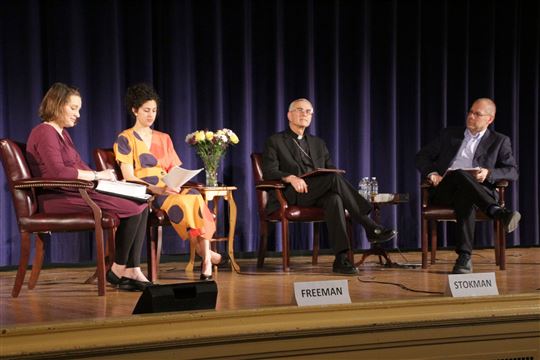
The Life of Luigi Giussani: What Does it Mean to Follow?
On March 17 in Evansville, Indiana, Alberto Savorana continued on his Life of Luigi Giussani book tour speaking alongside Bishop Steven Raica, Stephanie Stokman, and Emily Freeman. Read the full story."I see what you see, but I see more." With this quotation Bishop Steven Raica began the Life of Luigi Giussani presentation in Evansville, Indiana, on March 17. Although Raica did not have the opportunity to personally meet Msgr. Luigi Giussani, who died fourteen years ago, he claimed Giussani had a large impact on his life. His statement shed light on the possibility for all who did not have the chance to bump into Giussani when he was alive to truly meet him and discover his proposal through community. "Paradoxically, I think I have met him because I have met him through those who knew him, and they have not disappointed me," he said.
Raica then walked the audience through the journey of his education. As a young man, he was taught to work hard, get a good job, prosper, and move up the self-made ladder taking no risks. The encounter with Giussani allowed him to realize that this outlook on work was inadequate: Focusing solely on one’s plans and accomplishments is not sufficient to respond to the basic human needs for love and freedom.
Addressing the crisis the Church is currently facing, Raica subsequently reflected on a recent meeting with men and women preparing to receive baptism in April. In light of the latest scandals, he said, it may seem surprising that one would wish to commit to joining the Church, but it should not be. In fact, in the first century, "When becoming a Christian brought almost certain martyrdom, people young and not so young continued to encounter Christ in the least expected ways and were drawn to him." Those who join the Christian community, claimed Raica, testify the power of the announcement of the Incarnation of God.
Following Raica, Stephanie Stokman, mother and by default educator, spoke of the impact that Giussani had on her education and that of her children. Find Stokman's full remarks here.
Author and journalist Alberto Savorana finally offered guidance on how to approach his recent book, The Life of Luigi Giussani, as well as the books Giussani wrote during his lifetime. Rather than getting stuck on what is in print, he said that “we learn [to see the Mystery with Fr. Giussani] day by day,” and claimed that living in this way allows for Giussani to become more real. Not shy to interrupt and dialogue with moderator Emily Freeman, Savorana had a way of relaying some of Giussani’s deepest concerns as well as further explaining just what kind of method Giussani offered the Church and the world.
“Christianity,” he reminded, “is an announcement charged with a message.” He recounted how half of the students who had been with Giussani from the beginning of Gioventú Studentesca left him in 1968. Those who remained could see that it was necessary and reasonable to start again on the journey as the “calling forth of their humanity absolutely [sprang] forth from Another.” It did not matter that Giussani’s method had become less than popular, because it struck them as a true and worthy path. Giussani did in fact see more, but he gave them space to decide! They could test and see if what he said would hold true: I see what you see, but I see more. What they perceived in those days, said Savorana, was the experience of a Presence Giussani brought them before any of his books were even written.
To follow a man like Giussani is to follow the object of his gaze. So, with our panelists, we looked at our lives and at ourselves in light of the Gospel without reducing our faith to merely one facet of our existence. Unmistakably, Giussani’s statement that the Mystery is “all in all” is a lesson learned in our daily circumstances.#LifeLuigiGiussani